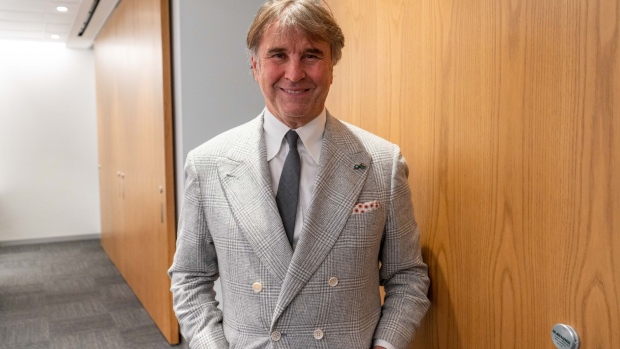Feb 4, 2023
Billionaire Cucinelli Sets Profits Cap to Thrive for Centuries
, Bloomberg News

(Bloomberg) -- Brunello Cucinelli likes making money but the Italian billionaire wants his workers and suppliers to benefit too. In an industry which posts eye-popping margins, his namesake luxury cashmere house pours profits into better pay and working conditions. Investors, so far, appear to be on board.
Since listing in Milan in 2012, shares in Brunello Cucinelli SpA — purveyor of €13,500 ($14,900) curly shearling capes and €800 cashmere hoodies — have increased about 10-fold, widely outperforming the MSCI Europe Textile Apparel and Luxury Goods Index.
But that hasn’t tempted Cucinelli, 69, to reconsider his approach of targeting an earnings before interest, taxes, depreciation and amortization margin, net of IFRS-16, of about 18%, a level he calls fair.
“When we decided to list, bankers told us we needed to target 30% sales growth every year,” Cucinelli, who’s founder and chairman, said in an interview in Milan. “I said, ‘forget it! If you want a company that makes profits by going against the principles of humanity, don’t buy us’.”
The company has since struck a chord with younger luxury buyers who demand to know, “how did you make your profits, have you been respectful of people, have you damaged the environment?,” Cucinelli said.
Some of the founder’s more traditional ideas about sustainability also resonate in the medieval village where the fashion house is based, Cucinelli said, citing everything from relationships with suppliers to paying garment workers more than many other companies do.
ESG Pioneer
“Sustainability is becoming more important to investors overall but especially in the luxury industry where the key message is ‘buy less buy better’ and Cucinelli has been a pioneer in the ESG field,” said Swetha Ramachandran, lead manager of the GAM Luxury Brands Fund.
Over the past 12 months the stock has risen more than 50%. Still, the shares last month saw downgrades from brokers including Bank of America Corp. and Exane BNP Paribas, which both moved the stock’s rating to underperform.
“Cucinelli trades at a premium to Hermes and other pure luxury players for growth that’s in line with theirs,” added Angelo Meda, head of equities at Banor Sim.
The founder remains convinced he’s on the right path. “People buy our products because they like our style, but also because they know how we work,” Cucinelli said.
Cucinelli’s workshops feature grand picture windows overlooking the surrounding countryside, giving artisans access to natural light. The founder encourages them to “take a minute to look at the sky, listen to the church bells, instead of only sewing and stitching in a basement,” and he said he’s proud none of his roughly 2,000 employees were let go when sales were hit by the pandemic.
No one at Cucinelli — managers included — is allowed to work later than 5:30 p.m. Operations shut down for an hour and a half for a traditional lunch break. There are no badges for “swiping,” a word the founder uses derisively. And work-related emails are banned on weekends.
“People need to spend time with their families,” explains Cucinelli, who happily shares details about his two daughters, and asks reporters interviewing him about their own children. His family still controls the firm, now worth over €5 billion, through a 50.05% holding.
Dyed in the Wool
Cucinelli founded the company in the central Italian region of Umbria in 1978, making a name for himself with the then-revolutionary idea of dying cashmere.
In the 1980s, he bought a crumbling 14th-century castle and made it his headquarters. Today, the surrounding area features cultural assets like a theater and library funded by the Cucinelli foundation.
The company reported a 2021 Ebitda margin of 15.4% net of IFRS-16 effects, and for 2023, Cucinelli expects revenue growth around 12%, meaning the fashion house could reach the milestone of €1 billion in sales.
“Consistency and predictability” are the main reasons the shares have appreciated in recent years, said Bernstein luxury goods analyst Luca Solca.
“Cucinelli has always communicated in a precise way, no change in guidance,” Solca said. “You have in your portfolio an equity that behaves like a bond, no surprises.”
For his part, the founder says he’ll keep investing in craftsmanship and avoid brand-diluting “second-line” collections or flashy partnerships.
That may cap short-term growth, but Cucinelli sees slow and steady development as the key to keeping the firm strong in the future.
“We want this company alive and kicking for another 200 years,” Cucinelli said. “You can’t grow 30% every year for two centuries.”
©2023 Bloomberg L.P.


